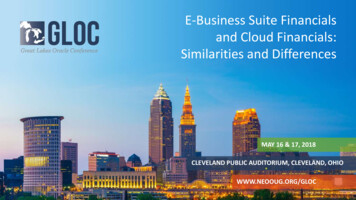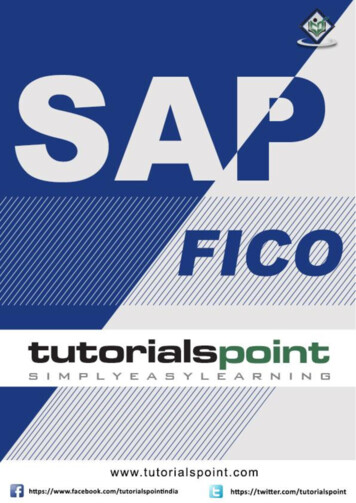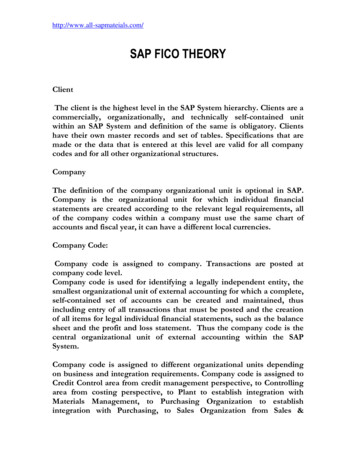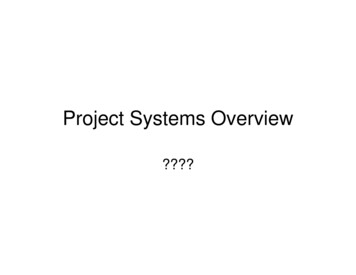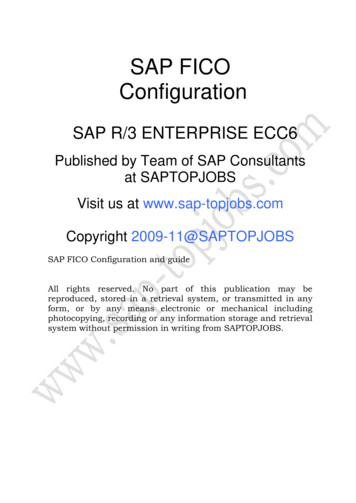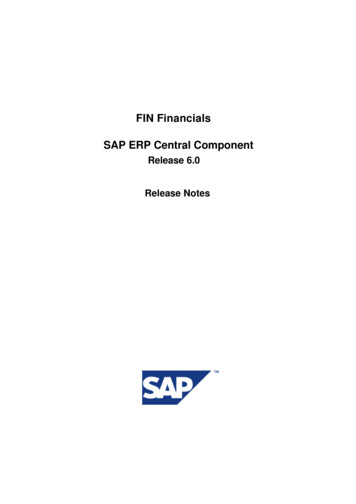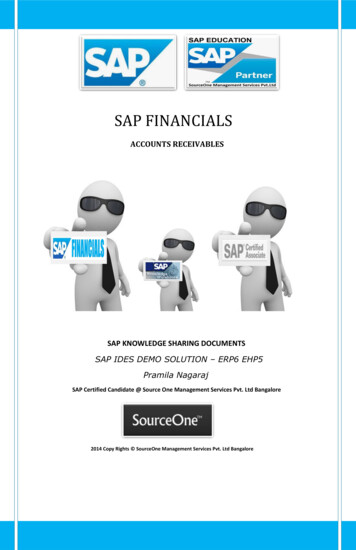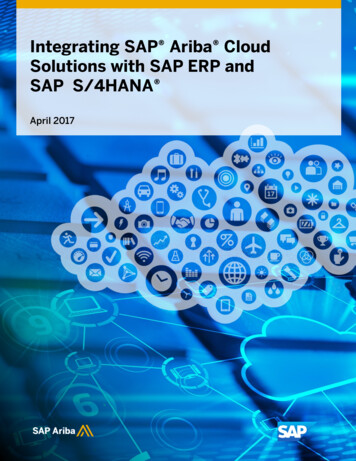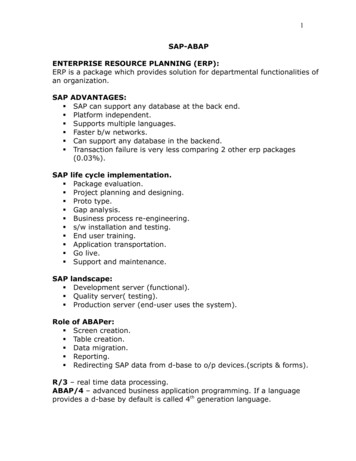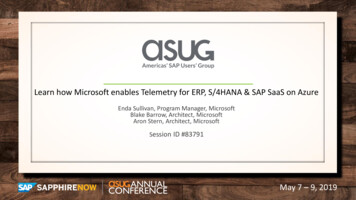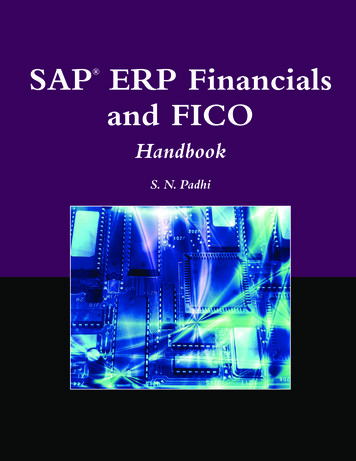
Transcription
SAP ERP Financialsand FICO HandbookS. N. Padhi
SAP ERP Financialsand FICO Handbook
THE JONES AND BARTLET T PUBLISHERS SAP BOOK SERIESSAP R/3 FI TransactionsV. Narayanan (978-1-934015-01-8) 2007Upgrading SAP Maurice Sens (978-1-934015-15-5) 2008SAP FI/CO Questions and AnswersV. Narayanan (978-1-934015-22-3) 2008SAP ABAP HandbookKogent Learning Solutions, Inc. (978-0-7637-8107-1) 2010SAP ABAP Questions and AnswersKogent Learning Solutions, Inc. (978-0-7637-7884-2) 2010SAP MM Questions and AnswersKogent Learning Solutions, Inc. (978-0-7637-8144-6) 2010SAP SD Questions and AnswersKogent Learning Solutions, Inc. (978-0-7637-8198-9) 2010SAP ERP Financials and FICO HandbookS. N. Padhi (978-0-7637-8080-7) 2011For more information on this series and its titles, please visit us online athttp://www.jbpub.com. Qualified instructors, contact your Publisher’s Representative at1-800-832-0034 or info@jbpub.com to request review copies for course consideration.
SAP ERP Financialsand FICO HandbookS. N. Padhi
World HeadquartersJones and Bartlett Publishers40 Tall Pine DriveSudbury, MA 01776978-443-5000info@jbpub.comwww.jbpub.comJones and Bartlett PublishersCanada6339 Ormindale WayMississauga, Ontario L5V 1J2CanadaJones and Bartlett PublishersInternationalBarb House, Barb MewsLondon W6 7PAUnited KingdomJones and Bartlett’s books and products are available through most bookstores and online booksellers. To contact Jones and BartlettPublishers directly, call 800-832-0034, fax 978-443-8000, or visit our website, www.jbpub.com.Substantial discounts on bulk quantities of Jones and Bartlett’s publications are available to corporations, professional associations,and other qualified organizations. For details and specific discount information, contact the special sales department at Jones andBartlett via the above contact information or send an email to specialsales@jbpub.com.Copyright 2011 by Jones and Bartlett Publishers, LLCAll rights reserved. No part of the material protected by this copyright may be reproduced or utilized in any form, electronic ormechanical, including photocopying, recording, or by any information storage and retrieval system, without written permission fromthe copyright owner.This publication contains references to the products of SAP AG. SAP, R/3, xApps, xApp, SAP NetWeaver, Duet, PartnerEdge,ByDesign, SAP Business ByDesign, and other SAP products and services mentioned herein are trademarks or registered trademarksof SAP AG in Germany and in several other countries all over the world. Business Objects and the Business Objects logo, BusinessObjects, Crystal Reports, Crystal Decisions, Web Intelligence, Xcelsius and other Business Objects products and services mentionedherein are trademarks or registered trademarks of Business Objects in the United States and/or other countries. SAP AG is neitherthe author nor the publisher of this publication and is not responsible for its content, and SAP Group shall not be liable for errors oromissions with respect to the materials.Production CreditsPublisher: David PallaiEditorial Assistant: Molly WhitmanProduction Director: Amy RoseProduction Editor: Kat CrightonAssociate Production Editor: Melissa ElmoreAssociate Marketing Manager: Lindsay RuggieroV.P., Manufacturing and Inventory Control:Therese ConnellComposition: diacriTechCover and Title Page Design: Scott ModenCover Image: Gastev Roman/ShutterStock, Inc.Interior Images: SAP AG. All rights reserved.Printing and Binding: Malloy, Inc.Cover Printing: Malloy, Inc.Library of Congress Cataloging-in-Publication DataPadhi, S. N.SAP ERP financials and FICO handbook/S.N. Padhi.p. cm.Includes index.ISBN 978-0-7637-8080-7 (hardcover)1. SAP ERP 2. Financing Corporation (U.S.) 3. Accounting—Computer programs. I. Title.HF5679.P23 2010657.0285'53—dc2220090373676048Printed in the United States of America13 12 11 10 910 9 8 7 6 5 4 3 2 1
This book is dedicated to my wife, Sharmistha.
ABOUT THE AUTHORA graduate in commerce and an associated member of the Institute of Charteredaccountants of India, New Delhi, S. N. Padhi has more than 26 years of experience inaccounting, finance, taxation, audit, and information technology. He is a participatingSAP FICO consultant.vi
TABLE OF CONTENTSAn Introduction to SAP SoftwarePrefaceChapter 1Interview Questions and 1.141.151.161.17Chapter 2Certification Questions and Answers2.12.2Chapter 3SAP-GeneralFI-GeneralEnterprise Structure (FI-ES)G/L Accounting (FI-G/L)Accounts Payable (FI-AP)Accounts Receivable (FI-AR)FI-AAGeneral COCO-CELFI-CCACO-PCACO-IOCO-PAProduct costing (CO-Pc)SDMMTechnical 1798084868789919595123Issues and Resolutions1273.13.23.33.4127128135143SAP GeneralGeneral Ledger (G/L) AccountingAccounts Payable (AP)Assets Management (AM)vii
viiiTABLE OF CONTENTS3.53.63.7Chapter 4Chapter 5Chapter 6Cost Center Accounting (CCA)Profit Center Accounting (PCA)New G/L156156157Configuration 161163168171174177177179181182183Enterprise Structure (FI-ES)General Ledger Accounting (FI-G/L)Accounts Payable (FI-AP)Accounts Receivable (FI-AR)Bank Accounting (FI-BL)Assets Accounting (FI-AA)Controlling Area (CO)Cost Center Accounting (CO-CCA)Internal Order (CO-IO)Profit Center Accounting (CO-PCA)Profitability Analysis (CO-PA)Product Costing (CO-PC)User Transaction 5209211217220224226General Ledger (G/L) AccountingAccounts Payable (AP)Accounts Receivable (AR)Assets Management (AM)Cost Element Accounting (CO-CEL)Cost Center Accounting (CO-CCA)Internal Order (CO-IO)Profit Center Accounting (CO-PCA)Profitability Analysis (CO-PA)Product Costing (CO-PC)FICO Quick AP GeneralFI GeneralGeneral Ledger (G/L) AccountingAP and ARAsset Accounting (AA)CO GeneralCEL
TABLE OF CONTENTS6.86.96.106.116.12Chapter 7Chapter 8Chapter 9Cost Center Accounting (CCA)IOPAPCAPCCix255257258261263Special 266269271273275276277278279280281Foreign CurrenciesIntercompany TransactionsBank ReconciliationLockbox ConfigurationRevenue RecognitionAutomatic Payment ProgramThree-Way MatchP2PVendor Down Payment and ClearingOrder to Cash (OTC)Make to OrderSummarization Levels in CO-PANew GL2858.18.2288289Document SplittingTransaction CodesTables in the SAP 4295295296296Enterprise Structure (FI-ES)General Ledger Accounting (FI-G/L)Accounts Receivable (FI-AR)Accounts Payable (FI-AP)Assets Management (FI-AA)General (CO)Cost Center Accounting (CO-CCA)Profit Center Accounting (CO-PCA)Profitability Analysis (CO-PA)Chapter 10SAP MM Configuration297Chapter 11SAP SD Configuration301Index305
AN INTRODUCTION TO SAP SOFTWARESAP stands for Systems Applications and Products in Data Processing.SAP software is the leading enterprise information and management package worldwide.Use of this package makes it possible to track and manage, in real time, sales, production,financial accounting, and human resources in an enterprise.SAP AG is the third-largest software company in the world. Founded in 1972, SAP nowemploys more than 48,500 people in more than 50 countries. SAP global headquartersis located in Walldorf, Germany, and the company is listed on several stock exchanges,including the Frankfurt DAX and the New York Stock Exchange, under the symbol SAP.SAP has more than 2,400 partners, 26 industry solutions, and 12 million users at 140,000installations around the world.The following shortcuts are commonly used when working with SAP Possible ValuesCurrent DateShortcuts Enter F11, Ctrl SF3Shift F3F12F1F8F4F4 and F2TABLE 1Shortcutsxi
PREFACEThis book is different from other books available on the market. The main goals of thisbook are to provide readers with a good knowledge base, to offer a better understandingto those new to SAP Financial Accounting (FI) and Controlling (CO), and to sharpenthe skills of experienced consultants.While writing this book, utmost care was taken to cover the most common, complex,and highly interview-oriented topics of SAP FICO. In this book, you will find almost allsections are arranged according to the FICO submodules. The screenshots are takenfrom SAP R/3 Enterprise 4.70 and SAP ECC 6.0.This book is divided into the following chapters:nnnnnnChapter 1—Interview Questions and Answers: This chapter coversfrequently asked questions and answers in an interview format.More than 224 questions and answers are presented by sub-module.Chapter 2—Certification Questions and Answers: This chaptercontains nearly 200 “objective type certification” questions andanswers. This is one of the unique attributes of this book.Chapter 3—Issues and Resolutions: In this chapter, I explain theprobable solution of various production issues. Sometimes issuesand resolutions depend on a particular SAP implementationenvironment. This is another one of the unique attributes of thisbook not found in other books.Chapter 4—Configuration Steps: While implementing SAP R/3or SAP ERP Financials, consultants always look for sequentialsteps that need to be followed. In this chapter, I provide themost common object-oriented configuration steps in a sequencewith path and transaction codes.Chapter 5—User Transaction Codes: In this chapter, I providethe most common user transaction codes. It is expected that aFICO consultant know commonly used transaction codes.Chapter 6—FICO Quick Tour: In this chapter, I recap varioussub-modules of FICO in bullet-point format. This gives readersa high-level understanding of various sub-modules of FICO andis a valuable feature of this book.xiii
xivPREFACEnnnnnChapter 7—Special Areas: This chapter covers various areasof FICO that are highly important from an interview andimplementation perspective.Chapter 8—New G/L: The concept of the New G/L came intoexistence from SAP ECC 5.0 versions. It has many advantagescompared to earlier versions of SAP software. In this chapter,I give a high-level overview of the New G/L and how it isdifferent from G/L.Chapter 9—Tables in the SAP System: As you are aware, alltransactional data and configuration data is stored in variousdatabase tables. In this chapter, I provide various tablesimportant to SAP FICO modules.Chapter 10—SAP MM Configuration: SAP ERP ischaracterized by one-point data entry. Once data is enteredin one module, it flows to and affects other modules. As aFICO consultant, if you are working in a project where an SAPMaterials Management (MM) module is also implemented, youshould have a basic understanding of MM configuration. In thischapter, I cover some basic configuration steps.Chapter 11—SAP SD Configuration: Similar to Chapter 10, inthis chapter, you will find basic configuration steps of the SAPSales and Distribution (SD) module.I hope you will enjoy this book. All the best!S. N. Padhi
Chapter1I NTERVIEWQ UESTIONS ANDA NSWERS1.1 SAP-GENERAL1.What is the SAP implementation roadmap and what steps are involvedin it?The SAP implementation roadmap is a standard process provided by SAP AG forsmooth SAP implementation and is called the ASAP Roadmap. The ASAP Roadmapconsists of five phases: (1) Project Preparation, (2) Business Blueprint, (3) Realization, (4) Final Preparation, and (5) Going Live and Support.FIGURE 1.1 Project Preparation—In this phase of the ASAP Roadmap, decision-makers defineclear project objectives and an efficient decision-making process. Here, projectorganization and roles are defined and implementation scope is finalized.Business Blueprint—In this phase, the scope of the R/3 implementation is definedand the Business Blueprint is created. The Business Blueprint is a detailed documentation of the customer’s requirements.Realization—The purpose of Phase 3 is to configure the R/3 system. Theconfiguration is carried out in two steps: baseline configuration and finalconfiguration.1
2CHAPTER 1 2.INTERVIEW QUESTIONS AND ANSWERSFinal Preparation— The purpose of this phase is to complete the finalpreparation of the R/3 system for going live. This includes testing, user training, system management, and cutover activities to finalize your readiness togo live.Going Live and Support—During this phase, the first early watch session shouldbe held, where SAP experts analyze the system’s technical infrastructure. Theaim is to ensure the system functions as smoothly as possible.What does system landscape mean?The system landscape represents the SAP system deployment at your implementation site. Ideally, in an SAP environment, a three-system landscape exists,consisting of the development server (DEV), quality assurance server (QAS),and production server (PRD). This kind of setup is not primarily designed toserve as a server cluster in case of system failure; rather, the objective is to enhance“configuration pipeline elopmentsystemQuality assurancesystemProductionsystemFIGURE 1.2 System landscapeThe system landscape is the system structure that you have for your implementation project. For example, you might have a development system, qualityassurance (QA) system, and production system. It also includes how the configuration change goes through these systems and what controls there are. Systemlandscape mostly has to do with the systems, their servers, and so forth.
1.1 SAP-GENERAL3.3What are specs?Specs represent specifications. In an information technology (IT) environment, youwill find two kinds of specifications: (1) functional specifications and (2) technicalspecifications. These documents contain the business requirements, such as inputs,solutions, processing logic, and so on.Functional specification: The documentation typically describes what isneeded by the system user as w
to those new to SAP Financial Accounting (FI) and Controlling (CO), and to sharpen the skills of experienced consultants. While writing this book, utmost care was taken to cover the most common, complex, and highly interview-oriented topics of SAP FICO. In this book, you will find almost all sections are arranged according to the FICO submodules. The screenshots are taken
